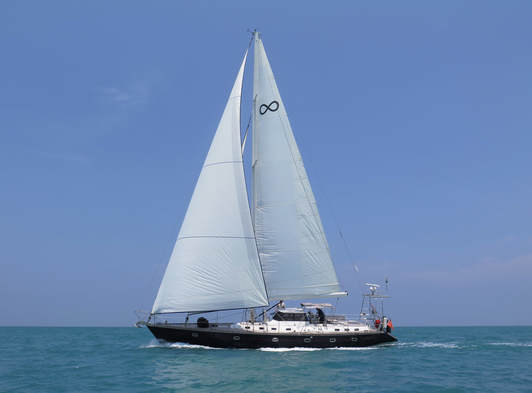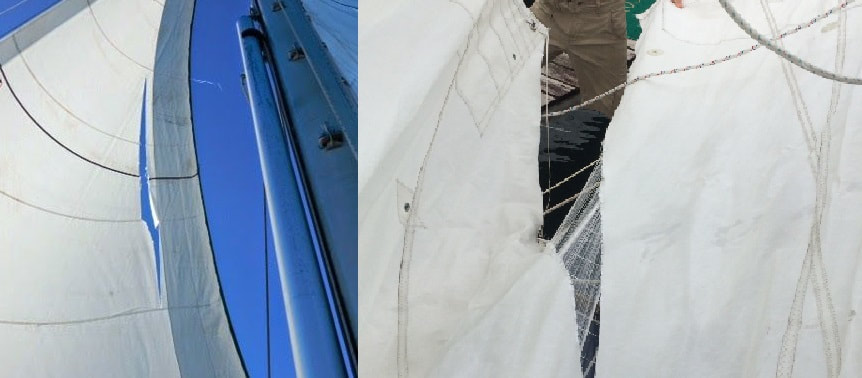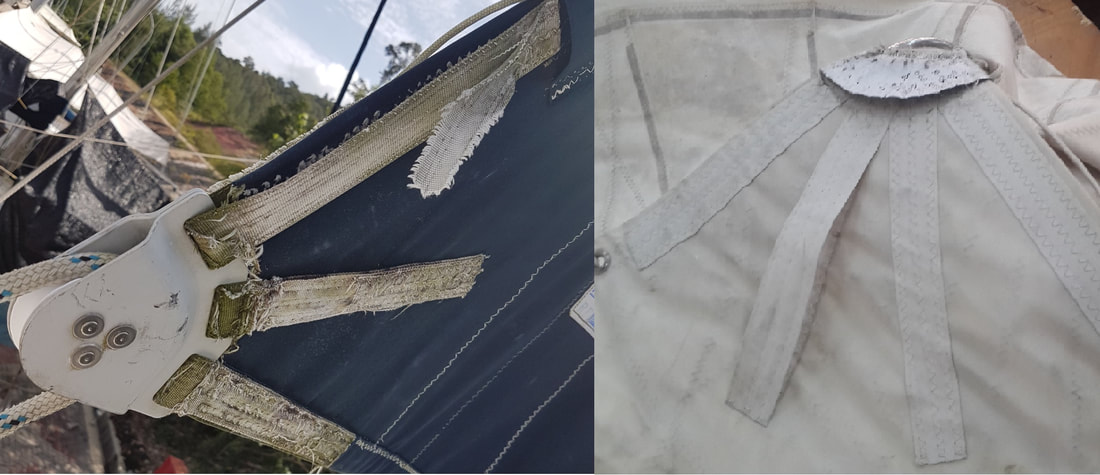|
The purpose of this article is to make cruisers aware of potential sail problems associated with blue water cruising. In remote locations sail repair service facilities can be non-existent therefore sail reliability is very important. We spent three years as full time cruisers and as a sailmaker and designer I have helped fellow cruisers deal with various sail issues. In this way I've attained a very good understanding of the sail problems faced by cruisers over the years evaluating and repairing damaged sails. In this first article we’ll talk about UV damage as it is a prime cause of sail problems for cruisers. Sail Cloth The most common cruising sail cloth is still woven polyester (dacron) so we'll focus our attention here in this article. Dacron (polyester) sailcloth degrades at a steady rate in UV light and obviously should always be kept covered when not in use. Some tell tale signs that dacron is sun damaged are a yellow discoloration and a slightly furry look to the fabric surface. The fabric will also tear easily and small 2 or 3mm holes may appear. Before embarking on a long passage it is worth having a close inspection of your sails to identify any cloth problems. The more UV hours the dacron is subjected to, the more the strength loss. While dacron sailcloth may all appear to look the same to the untrained eye, there are at least 5 different manufacturers, each having 2-4 different grades of dacron in their range. Even with a lot of research it is still tough for the customer to know which cloth is high quality and which is low. We weather and stretch tested as many dacrons as we could with some surprising results. We found a massive variation in strength loss due to UV damage – up to 90% strength loss in 6 months for some fabrics, while others are as low as 30%. We put this down to the different types of polyester yarns used in the construction and the different resins/coatings used in the manufacturing process. We use Dacron with a fairly balanced weave as opposed to high aspect dacron. This avoids vertical tearing (as seen in above photo), high aspect dacron has most of its strength in only one direction. We only use dacron from trusted suppliers that has performed well in our UV testing. UV Cover stitching One of the most common problems is when the Sunbrella or Acrylic UV cover on genoas and furling mainsails separates from the sail due to stitching failure caused by UV damage. While some UV polyester threads will last well we typically see the stitching on the UV cover failing after 3-5 years in tropical sun. This can lead to the UV cover partly detaching and flogging apart. The dacron material of the sail is then subjected to 24 hour UV damage until the sail can be repaired. The solution is PTFE (Teflon) thread which is not affected by UV light and will outlast any fabric including Sunbrella. Sold under many brand names the most common being Gore - Tenara this thread has been around for many years, but is rarely used by sail manufacturers. We sew all our sail UV covers with this product and the extra cost of the thread is overall a big saving of money and headache later on. Corners
Another less common but more serious problem on furling sails is when the stitching and webbing holding the corner rings or loops to the sail degrades so that the corner fails. In the photos above the stitching has degraded to a point where if the sail corner was subjected to a strong load, the ring or pulley would separate from the sail. While we cover all our corner webbing with Sunbrella or UV material and sew it with PTFE Tenara thread, many sailmakers do not. Polyester thread can lose 50% of its strength after 1 year in the sun. Exposing the thread and webbing holding the corner ring (which is regularly taking hundreds of kgs of load) to constant UV is a really bad idea in a tropical climate. We've seen many of these webbings hand stitched or even riveted back on to the sail. The corner webbing is also susceptible to UV damage, so here we cover all webbing with polyester tube webbing or sunbrella. Mainsails and hanked on genoas are also susceptible to corner failure due to UV damage. So it is important to make sure their sail bags and covers completely cover the sail corners. We too often see the corners poking out the ends of the covers. I hope you enjoyed this article, and please like us on facebook for future articles and updates. |
|
Proud supporter of Sea Shepherd
|










